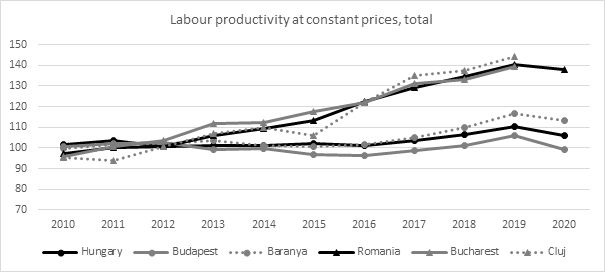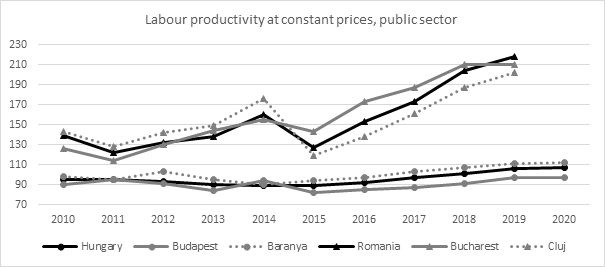Firm Dynamics and Labour Productivity in Two Regional Centres: Old and New Challenges in the Post-COVID Period
Zsuzsanna Zsibók – Ildikó Egyed
In the aftermath of the 2008 financial crisis, the economic trajectories of European cities have become a focal point for researchers and policymakers. A recent comparative study investigates the firm dynamics and labour productivity of two secondary cities: Cluj-Napoca in Romania and Pécs in Hungary. This analysis sheds light on how these cities have addressed post-crisis challenges and offers insights into their economic resilience.
Divergent Economic Paths
Cluj-Napoca and Pécs, both significant urban centers in their respective countries, have experienced contrasting economic developments since the crisis. Cluj-Napoca has emerged as a dynamic hub, attracting investments and fostering a vibrant business environment. In contrast, Pécs has faced economic stagnation, grappling with challenges in revitalizing its industrial base and attracting new enterprises. In this research we aim to gain insight into the development potential of second-tier cities, that are themselves developed, but whose regional hinterland/wider regional context is underdeveloped. The regional-level analysis indicated that Baranya is lagging behind the Hungarian average in terms of labour productivity, while Cluj performs well above the Romanian average. In the public sector, the differences are similar, albeit smaller. The distribution of production and employment is more concentrated in Hungary, with the capital having a higher share of national output and employment compared to Romania. The distribution of gross value added and employment shows a slightly more balanced picture in the public sector. Hungary and Baranya have an advantage over Romania and Cluj in terms of employment growth, both in the public sector and in the economy as a whole. However, employment growth in Hungary has not been accompanied by productivity improvements, which is why Romania and Cluj are far ahead in this respect, and Hungary’s labour productivity is, indeed, stagnating.
Labour productivity growth at national and NUTS3 level in the total economy and in the public sector (2009 = 100)


Micro-level analysis
The firm-level analysis points to notable differences in the size of the economies of the two cities, and while a critical mass of high economic potential has been found in Cluj-Napoca, this is utterly lacking in the case of Pécs. The most striking difference is that among the 200 largest companies, Pécs shows a clear dominance of the public sector, while Cluj-Napoca has only one such company. Pécs has no company of national or international significance, while Cluj-Napoca hosts such companies, e.g. MOL. At the firm level, Pécs has a productivity advantage in the public sector, while Cluj-Napoca’s uncontested productivity advantage is in the private sector.
Cluj-Napoca concentrates a larger part of the economy of Cluj County than Pécs within Baranya County. 76 of the 100 largest employers in Cluj County are located in Cluj-Napoca, accounting for 81% of their employees, and 75 of the 100 largest companies in terms of revenue are located in Cluj-Napoca, accounting for 82% of their revenues. Of the 100 largest employers in Baranya County, only 51 are headquartered in Pécs, accounting for 70% of their employees, while 48 of the 100 largest companies in Baranya in terms of revenue are located in Pécs, accounting for 60% of their revenues.
Labour Productivity: A Tale of Two Cities
Labor productivity, measured as output per worker, serves as a critical indicator of economic health. Cluj-Napoca has demonstrated impressive gains in this area, driven by a diversified economy that includes technology, services, and manufacturing sectors. The city’s investment in education and skill development has equipped its workforce to meet the demands of modern industries.
In contrast, Pécs has faced challenges in enhancing labour productivity. The city’s reliance on traditional industries, compounded with limited innovation, has hindered productivity growth. Efforts to modernize the industrial base and upskill the workforce have been sluggish, with important implications on overall economic performance.
The firm-level analysis showed that a strong public sector provides a degree of stability to the local economy, but is unable to contribute adequately to long-term growth, even in the presence of a strong higher education sector. The balance between the contribution of the public and private sectors to overall local development appears to be more favourable in Cluj than in Pécs. The study provides valuable insights into the factors that influence urban economic development and offers a roadmap for policymakers aiming to revitalize regional economies.
Zsuzsanna Zsibók and Ildikó Egyed. 2024. “Firm Dynamics and Labour Productivity in Two Regional Centres: Old and New Challenges in the Post-COVID Period.” Romanian Review of Regional Studies 18 (1–2): 11–23.


